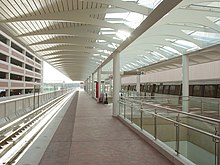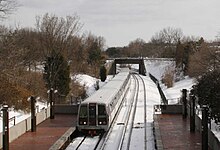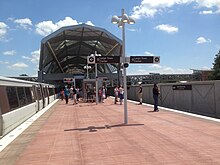| Revision as of 03:37, 16 November 2022 editAnomieBOT (talk | contribs)Bots6,564,245 edits Rescuing orphaned refs ("silverstations" from rev 1122099090)← Previous edit | Revision as of 15:58, 19 November 2022 edit undoBen270 (talk | contribs)218 editsNo edit summaryTags: Visual edit Mobile edit Mobile web editNext edit → | ||
| Line 1: | Line 1: | ||
| {{Short description|None}} | {{Short description|None}} | ||
| The ] (commonly called '''Metro''', and branded '''Metrorail''') is a ] system serving ] and neighboring communities in ] and ], both inside and outside the ]. With an average weekday ridership of 764,300, the Washington Metro is the ], behind the ].<ref name=APTA>{{cite web | title = Transit Ridership Report: First Quarter 2015 | publisher = American Public Transportation Association | date = 27 May 2015 | url = https://www.apta.com/resources/statistics/Documents/Ridership/2015-q1-ridership-APTA.pdf | format = PDF | access-date = 26 August 2015 | archive-url = https://web.archive.org/web/20150923173103/http://www.apta.com/resources/statistics/Documents/Ridership/2015-q1-ridership-APTA.pdf | archive-date = 23 September 2015 | url-status = dead }}</ref> {{As of|2022}}, the system has 97 active stations spread out on six lines with {{convert| |
The ] (commonly called '''Metro''', and branded '''Metrorail''') is a ] system serving ] and neighboring communities in ] and ], both inside and outside the ]. With an average weekday ridership of 764,300, the Washington Metro is the ], behind the ].<ref name=APTA>{{cite web | title = Transit Ridership Report: First Quarter 2015 | publisher = American Public Transportation Association | date = 27 May 2015 | url = https://www.apta.com/resources/statistics/Documents/Ridership/2015-q1-ridership-APTA.pdf | format = PDF | access-date = 26 August 2015 | archive-url = https://web.archive.org/web/20150923173103/http://www.apta.com/resources/statistics/Documents/Ridership/2015-q1-ridership-APTA.pdf | archive-date = 23 September 2015 | url-status = dead }}</ref> {{As of|2022}}, the system has 97 active stations spread out on six lines with {{convert|129|mi|km}} of tracks. Six more stations opened on November 15, 2022 as part of the Phase II of the ]<ref name=silverstations>{{cite news |url=https://www.washingtonpost.com/transportation/2022/06/09/metro-wmata-silver-line/ |title=Metro’s Silver Line extension moves closer to finish line |newspaper=The Washington Post |first=Justin |last=George |date=June 9, 2022}}</ref> and an infill station at ] is planned to open in early 2023 on the Yellow and Blue lines.<ref name=potomacyard>{{cite press release |url=https://www.wmata.com/about/news/Potomac-Yard-shutdown-extension.cfm |title=Metro announces delay to Potomac Yard construction project south of Reagan National Airport; Future station opening delayed until 2023 |publisher=Washington Metropolitan Area Transit Authority |date=September 30, 2022}}</ref> | ||
| The Washington Metro system was conceived as an alternative to the construction of a large ] system throughout the Washington, D.C. area and was partially financed with funds originally dedicated to highway construction.<ref>{{cite book |last=Schrag |first=Zachary |title=The Great Society Subway: A History of the Washington Metro |publisher=Johns Hopkins University Press |year=2006 |isbn= 0-8018-8246-X}}</ref> Construction began in 1969, and in 1976 the first section of the Metro system opened along the ] between the ] and ] stations in Washington, D.C. Throughout the 1970s and 1980s, more stations were opened in the city and the suburban communities of ], ], and ] in Virginia as well as ] and ] Counties in Maryland. By 1991, five rail lines were open: the Red, ], ], ], and ] Lines. The system as originally planned was completed in 2001 with the extension of the Green Line to ]. In 2004, three stations were opened: an extension of the Blue Line to the ] and ] stations and the first ], ].<ref name="WMATA History">{{cite web | title = WMATA History | publisher = Washington Metropolitan area Transit Authority | year = 2007 | url = http://www.wmata.com/about_metro/docs/history.pdf | format = PDF | access-date = 26 August 2015 | url-status = dead | archive-url = https://web.archive.org/web/20121015210314/http://wmata.com/about_metro/docs/history.pdf | archive-date = 15 October 2012 }}</ref> In 2014, the ] opened with five new stations: ], ], ], ], and ].<ref name=metrofacts>{{cite web|url=http://www.wmata.com/about_metro/docs/Metro%20Facts%202014.pdf |title=Metro Facts |year=2014 |publisher=Washington Metropolitan area Transit Authority |access-date=26 August 2015 |url-status=dead |archive-url=https://web.archive.org/web/20160222003449/http://www.wmata.com/about_metro/docs/Metro%20Facts%202014.pdf |archive-date=22 February 2016 }}</ref> | The Washington Metro system was conceived as an alternative to the construction of a large ] system throughout the Washington, D.C. area and was partially financed with funds originally dedicated to highway construction.<ref>{{cite book |last=Schrag |first=Zachary |title=The Great Society Subway: A History of the Washington Metro |publisher=Johns Hopkins University Press |year=2006 |isbn= 0-8018-8246-X}}</ref> Construction began in 1969, and in 1976 the first section of the Metro system opened along the ] between the ] and ] stations in Washington, D.C. Throughout the 1970s and 1980s, more stations were opened in the city and the suburban communities of ], ], and ] in Virginia as well as ] and ] Counties in Maryland. By 1991, five rail lines were open: the Red, ], ], ], and ] Lines. The system as originally planned was completed in 2001 with the extension of the Green Line to ]. In 2004, three stations were opened: an extension of the Blue Line to the ] and ] stations and the first ], ].<ref name="WMATA History">{{cite web | title = WMATA History | publisher = Washington Metropolitan area Transit Authority | year = 2007 | url = http://www.wmata.com/about_metro/docs/history.pdf | format = PDF | access-date = 26 August 2015 | url-status = dead | archive-url = https://web.archive.org/web/20121015210314/http://wmata.com/about_metro/docs/history.pdf | archive-date = 15 October 2012 }}</ref> In 2014, the ] opened with five new stations: ], ], ], ], and ].<ref name=metrofacts>{{cite web|url=http://www.wmata.com/about_metro/docs/Metro%20Facts%202014.pdf |title=Metro Facts |year=2014 |publisher=Washington Metropolitan area Transit Authority |access-date=26 August 2015 |url-status=dead |archive-url=https://web.archive.org/web/20160222003449/http://www.wmata.com/about_metro/docs/Metro%20Facts%202014.pdf |archive-date=22 February 2016 }}</ref> | ||
Revision as of 15:58, 19 November 2022
The Washington Metro (commonly called Metro, and branded Metrorail) is a rapid transit system serving Washington, D.C. and neighboring communities in Maryland and Virginia, both inside and outside the Capital Beltway. With an average weekday ridership of 764,300, the Washington Metro is the second-busiest rapid transit system in the United States, behind the New York City Subway. As of 2022, the system has 97 active stations spread out on six lines with 129 miles (208 km) of tracks. Six more stations opened on November 15, 2022 as part of the Phase II of the Silver Line and an infill station at Potomac Yard is planned to open in early 2023 on the Yellow and Blue lines.
The Washington Metro system was conceived as an alternative to the construction of a large freeway system throughout the Washington, D.C. area and was partially financed with funds originally dedicated to highway construction. Construction began in 1969, and in 1976 the first section of the Metro system opened along the Red Line between the Rhode Island Avenue and Farragut North stations in Washington, D.C. Throughout the 1970s and 1980s, more stations were opened in the city and the suburban communities of Arlington County, the City of Alexandria, and Fairfax County in Virginia as well as Montgomery and Prince George's Counties in Maryland. By 1991, five rail lines were open: the Red, Blue, Green, Orange, and Yellow Lines. The system as originally planned was completed in 2001 with the extension of the Green Line to Branch Avenue. In 2004, three stations were opened: an extension of the Blue Line to the Downtown Largo and Morgan Boulevard stations and the first infill station, NoMa–Gallaudet U. In 2014, the Silver Line opened with five new stations: Greensboro, McLean, Spring Hill, Tysons, and Wiehle–Reston East.
Nine Metrorail stations are officially designated transfer stations, although other intermediate stations also allow passengers to transfer between lines. Four of those stations have separate, perpendicular upper and lower levels which opened at different times. Two other transfer stations, Rosslyn and Pentagon, have parallel stacked platforms. Ten stations are termini (stations at the end of lines); several other non-terminus stations are used to short turn trains in regular service.
As of May 2016, Union Station was the busiest station in the system, with an average of 28,864 passenger boardings per weekday. Nine of the top ten busiest stations are in the District of Columbia. Metro Center, a transfer point for the Blue, Orange, Silver, and Red Lines, is the busiest transfer station, with 24,160 boardings. Shady Grove in suburban Montgomery County, Maryland was the busiest terminus with 11,696 passenger boardings per weekday.
Contents
Lines
There are six Washington Metro lines, each named for a different color. All lines except the Red Line share tracks.
| Line | Ridership (May 2010) | Stations | Termini | |
|---|---|---|---|---|
| 277,741 (37%) | 27 | Glenmont | Shady Grove | |
| 187,663 (25%) | 26 | New Carrollton | Vienna | |
| 120,104 (16%) | 27 | Franconia–Springfield | Downtown Largo | |
| 105,091 (14%) | 21 | Branch Avenue | Greenbelt | |
| 59,781 (8%) | 21 | Huntington | Greenbelt | |
| — | 34 | Ashburn | Downtown Largo | |
Stations










| * | Official transfer stations |
| † | Terminals |
| *† | Transfer station and terminal |
Future stations

Potomac Yard, planned to open in early 2023, is an infill station between Braddock Road and National Airport on the Yellow and Blue lines.
| Station | Lines | Jurisdiction | Projected Opening | Reference |
|---|---|---|---|---|
| Potomac Yard | Alexandria, Virginia | Early 2023 |
Notes
- Stations noted in this list twice with upper and lower levels are considered by WMATA to be a single station. The levels are noted separately here because they opened on different dates.
References
- "Transit Ridership Report: First Quarter 2015" (PDF). American Public Transportation Association. 27 May 2015. Archived from the original (PDF) on 23 September 2015. Retrieved 26 August 2015.
- George, Justin (June 9, 2022). "Metro's Silver Line extension moves closer to finish line". The Washington Post.
- ^ "Metro announces delay to Potomac Yard construction project south of Reagan National Airport; Future station opening delayed until 2023" (Press release). Washington Metropolitan Area Transit Authority. September 30, 2022.
- Schrag, Zachary (2006). The Great Society Subway: A History of the Washington Metro. Johns Hopkins University Press. ISBN 0-8018-8246-X.
- "WMATA History" (PDF). Washington Metropolitan area Transit Authority. 2007. Archived from the original (PDF) on 15 October 2012. Retrieved 26 August 2015.
- ^ "Metro Facts" (PDF). Washington Metropolitan area Transit Authority. 2014. Archived from the original (PDF) on 22 February 2016. Retrieved 26 August 2015.
- ^ "Stations". Washington Metropolitan Area Transit Authority. Retrieved December 28, 2017.
- ^ "Metrorail Average Weekday Passenger Boardings" (PDF). WMATA. May 2017. Retrieved January 24, 2018.
- ^ "Metro Media Guide" (PDF). Washington Metropolitan Area Transit Authority. 2010. Archived from the original (PDF) on July 28, 2012. Retrieved July 14, 2011.
| Washington Metropolitan Area Transit Authority | |
|---|---|
| Subsidiaries | |
| Metrorail lines | |
| Bus rapid transit | |
| Other topics | |
| Transit in Metropolitan Washington, D.C. | |
|---|---|
| Agencies | |
| Washington Metro | |
| Commuter rail | |
| Inter-city rail | |
| Bus |
|
| Bus rapid transit | |
| DC Streetcar | |
| Aviation | |
| Future projects | |